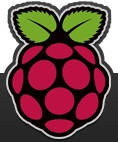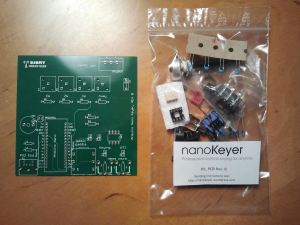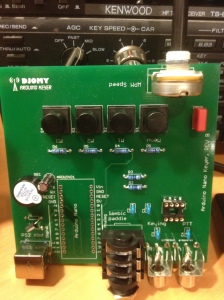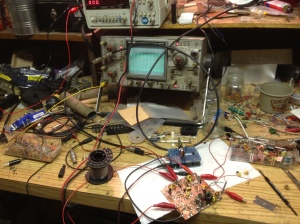Posts Tagged ‘Uncategorized’
 Decisions
Decisions
Yesterday while I was continuing my research into new rigs, my TS-850 stopped working with a dead silent receiver. I pretty much wrote off the rig thinking it wasn’t worth the repair and I would be getting out the credit card and picking up the phone to place an order for its replacement. But my good friend K3PH happened to see my rig death announcement on Facebook and posted a link to a Kenwood service bulletin about a known issue with Kenwood 850 receivers going dead. For giggles I opened up the rig and checked the “RXB” voltage point, and sure enough it had the symptoms of the issue. I replaced one culprit SMT diode with two run-of-the-mill 1N914 diodes and the rig came back to life. As if that wasn’t enough, the CW QSK is now much better, with full break actually much quieter and smoother than before. It’s like the rig has a second lease on life.
So for now the decision that seemed eminent is postponed while I enjoy my reborn Kenwood 850. I’m still mulling over the choices for a new rig, but I think I have it down to the Kenwood TS-590 and the Yaesu FT-950. Despite my initial thoughts of abandoning Kenwood altogether, the 590 seems to have some of the old Kenwood flair I liked years ago. I’ve ruled out the K3, KX3, and Ten Tec Jupiter. The Ten Tec Eagle is getting pushed out of the race. I haven’t seriously considered Icom, but perhaps I should take the extra time to look at them.
So far the Kenwood and Yaesu offerings are neck-and-neck in the race, though from review comments, going through the manuals, and my experiences with other Yaesu products, I get the feeling the Kenwood interface may be more user friendly than the Yaesu menus. I do like the front CW key jack, the separate RCA REC and PTT jacks, and the rotator integration feature in the Yaesu. I wish I had an amateur radio store nearby I could touch each of these rigs.
Last night I operated during the CQ 160 phone contest with the 850. I ran 100 watts to an inverted L with a meager seven or eight short radials on my acre lot, and I worked all but perhaps four or five stations in the midwest who couldn’t hear me. It was like shooting fish in a barrel and quite fun, and really speaks to what you can do with a modest antenna on 160.
 Big Day Out at Wyong
Big Day Out at Wyong
Just back from a few hours spent at the annual field day at Wyong hosted by the Central Coast Amateur Radio Club. This has to be the big day out for Australian radio amateurs. People came from near and far. It’s a good barometer of the health of the hobby and the local industry supporting it.
I was delighted to see – as the first exhibit as you enter – a full display of the Elecraft K-line presented by Gary VK4FD. Only thing missing was a KX3. Gary of course is an enthusiast, not an employee of Elecraft. A pretty good indicator of the passionate support the company enjoys.

The flea market became pretty busy as the morning progressed, but maybe not as many stalls as previous years. One stall that stood out for me at least was Stephen VK2SPS’s which included his offering of keys and bugs, surplus to his collection as he focuses on homegrown Australian manufactured keys. Eagle-eyed visitors will spot the McElroy bug (top, centre) and an interesting wooden based French military key towards bottom right.

Brilliant sunny weather, but not too hot to spend some time wandering about looking for a bargain or three. Also saw an impressive display of homebrew gear from members of the ARNSW Homebrew group.
 nanoKeyer
nanoKeyer
I’m pleased to report that Oscar, DJ0MY, has created an open source hardware initiative and kit offering called nanoKeyer. This project utilizes my Arduino keyer code and the Arduino Nano, a smaller cousin of the Arduino Uno, but fully software compatible.
Oscar is offering the kit at a reasonable price, but also provides Gerber files on his site for those wishing to reproduce the hardware design. The hardware kit features three memory buttons, a speed potentiometer, a PS2 Keyboard connector, and optically-isolated keying and PTT lines. The Arduino Nano module that mates with the nanoKeyer supports the K3NG keyer code command line interface and K1EL Winkey emulation via the built-in USB port. The Arduino Nano is programmed via a typical Windows, Mac, or Linux machine with free software.
This kit offers commercial / contest quality performance and features in an open source package that can easily be assembled by beginners or customized by advanced experimenters.
 Choices
Choices
Lately I’ve been thinking (again) about getting a new rig and replacing an older Kenwood. I’ve actually cleaned up the shack a bit and have removed some little monoband rigs that I rarely use and have gotten down to the basics of just what I need. I feel I need something new in the shack, I’m just not sure what.
The Elecraft K3 would be a no brainer choice. While it’s a great rig, it somewhat has the makings of a fad for me, and I’ve never been a trend follower.
The KX3 is another option. I kind of like the idea of a portable rig that has the potential for being a primary home shack rig at 100 watts. But I still have concerns about the form factor, with the rig being so small and for portable backpack use it seems a bit fragile. I don’t know if I could be satisfied with it as a home base rig.
I would love to try a Flexradio, however each day I’m leaning more towards Mac in the shack (gasps from the audience). The last time I looked at Flex they still weren’t supporting Vista or Windows 7. Perhaps that’s changed but support for OSX is likely light years away.
Nothing that Kenwood currently offers excites me. Unfortunately I doubt I’ll ever buy a Kenwood HF rig again.
Maybe I should go with a Yaesu rig? The FT-950 looks like a reasonable choice, though a bit uninspiring. The price is right and it gets good reviews. It appears to be a good performing rig without needless extravagance like multi-kilobuck contester rigs. I’m quite pleased and familiar with the FT-817 and FT-897, so this rig would not be difficult to assimilate into the shack, though it doesn’t really get me into uncharted territory and it seems like a “safe” choice.
Perhaps it’s time I tried a Ten Tec? The Ten Tec Jupiter is kind of spartan-looking, but interesting. I like the clean look and under the hood it seems to have a lot of technology and power. One downside I see is that the MARS mod is not readily available. I modify all my rigs for DC to daylight transmit for emergency use and so I can use them as signal generators. I’ve never used a Ten Tec but I know they are legendary performers.
I’ve used Icoms and I can’t say anything bad about them, they’ve just never been on my radar. I’m not sure why.
Any thoughts from the studio audience on what’s a good $1K – $2K HF-6m rig these days?
 Raspberry Pi
Raspberry Pi
The Raspberry Pi, which is a 700 Mhz ARM-based single board computer targeted at providing computing hardware to poor countries is going to be going into production soon. Two models called “A” and “B” are being offered, at approximately $25 and $35 (US). Options to purchase boards and donate money to provide units to needy folks around the world will be available. 
The concept of single board computers isn’t new, but the horsepower and price point of these units are. At this price range it puts the boards squarely in Arduino territory, but unlike the Arduino and other microcontrollers it will run a full blown OS. Several Linux distributions will be supported immediately and presumably BSD variants won’t be far behind. It will not run Windows or Windows emulation, like WINE. (Yes, I know WINE is not an emulator).
The board is equipped with a USB port that obviously can be used to interface with a multitude of devices, however it also includes a General Purpose I/O port or GPIO that supports, PWM, Serial UART and I2C capability. This will open the board up to hardware hackers like us. Sweet!
I’m pondering what amateur radio applications this could run. It has enough horsepower to do DSP. It would make a nice logging and contest appliance, with some well-designed software. How about an EchoLink or digimode appliance? Considering the low price it’s almost disposable and could make a powerful hot air balloon radio payload system controller. I may port my keyer code over to it for giggles. It will be interesting to see what uses radio artisans come up with.
 Kudos to CQ
Kudos to CQ
Often I complain about what we’re doing wrong or what we should be doing. This time is one of those exceptions where I have to pass kudos along. CQ Magazine has announced a “Maker” column which will be edited by Matt Stultz, KB3TAN, and will appear in several issues this year. The so-called maker movement has always been around, it’s just recently become more “hip” with the “maker” moniker and like with amateur radio the Internet provides a means for tinkerers to network, exchange ideas and information, and come together as a more organized movement. In my opinion amateur radio missed two prime opportunities with techie movements in the past, that of the open source world / Linux, and the wifi boom in the late 90s, early 2000s that led to wireless ISPs and got a lot of geeks interested in wireless but without amateur radio.
It’s great that CQ recognizes the opportunity and is taking advantage of it to bridge the maker and amateur radio worlds, and it just makes sense from a technical standpoint to introduce amateur radio to makers. Maker projects often have an element of mobility or remote control — projects that need wireless for control or data telemetry. Rather than just purchasing a mystery “black box” radio unit off-the-shelf and incorporating it into a project, makers have the opportunity with amateur radio to understand what’s going on inside the box, or bettet yet build that black box themselves. Introducing amateurs to the maker world will be beneficial as well, hopefully encouraging more amateurs to build and perhaps build projects outside of the normal QRP rig projects we tend to do. Overall this is a win-win situation for radio amateurs and makers.
 Back to the Lab
Back to the Lab
Here’s a project I’ve been working on which kind of started on a whim a few days ago. I’ve had two NJQRP DDS Daughtercards lying around, the older versions without the output amp update. I decided to interface one permanently to an Arduino and build a dual 10 and 6 meter beacon.
Is your lab as messy as mine?
The Arduino alternates the DDS frequency between 28 Mhz and 25 Mhz and CW keys the amplifier board. For the six meter transmitter chain I’m doubling the DDS 25 Mhz output to create the 50 Mhz six meter signal. Output power on each band will probably be around 250 mW. I’m probably going to put the unit in a weatherproof box, install it in the backyard, and attempt to power it with solar power. In addition to doing the CW keying and DDS programming, the Arduino will also measure and announce the battery voltage and perhaps the solar panel charge current. For antennas I’m thinking of simple wire loops.
Several years ago I ran a 100 mW ten meter beacon. I like lower power beacons; it’s more of a treat when people report hearing them. The previous ten meter beacon got quite a few DX reports from Europe during the last solar cycle.















